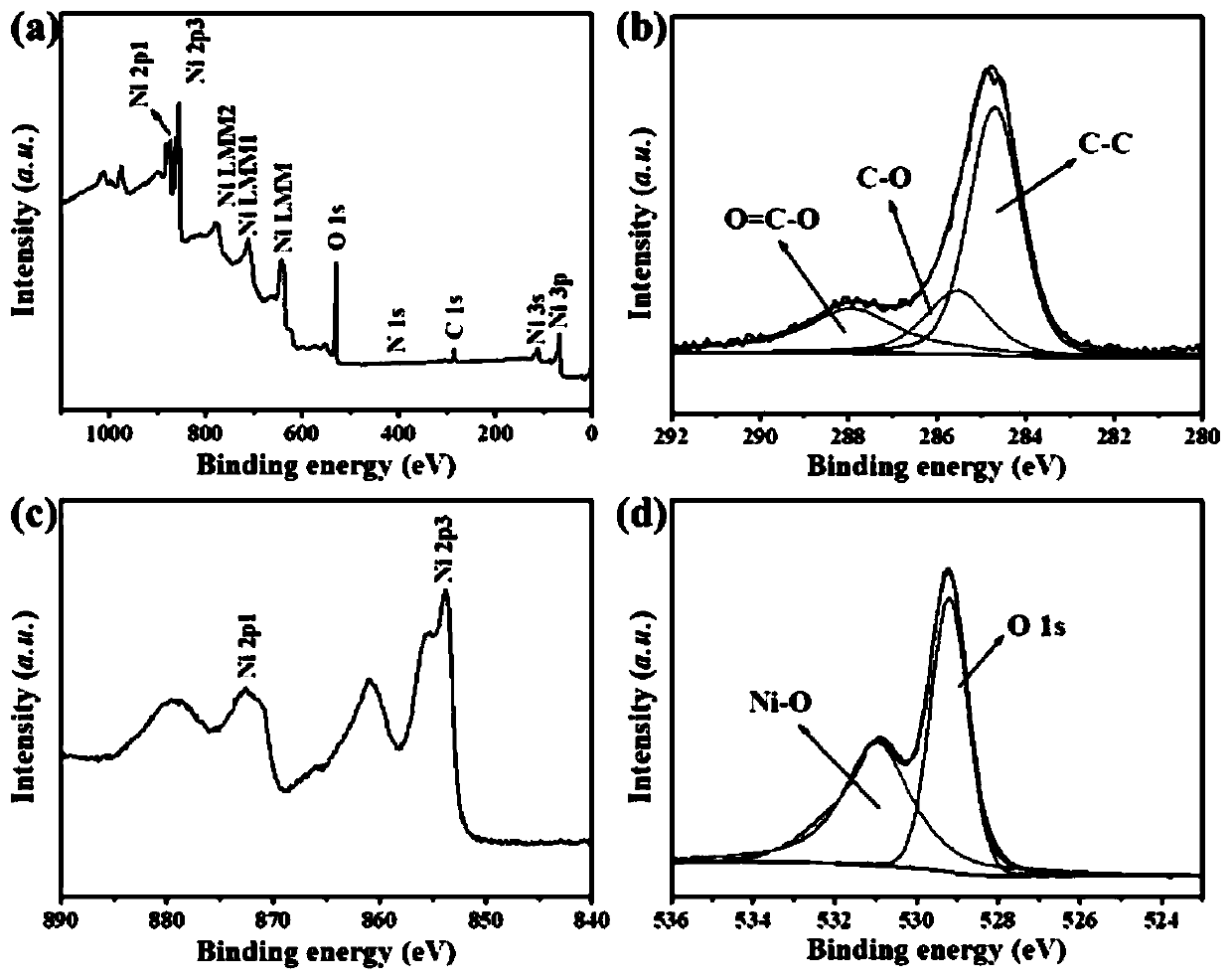Method for preparing active metal oxide-carbonized bacterial cellulose electrode material
A technology of bacterial cellulose and active metals, which is applied in the manufacture of hybrid capacitor electrodes and hybrid/electric double layer capacitors, etc., can solve the problems of easy agglomeration of active materials and achieve high capacity density and high dispersion
- Summary
- Abstract
- Description
- Claims
- Application Information
AI Technical Summary
Problems solved by technology
Method used
Image
Examples
Embodiment 1
[0028] In step 1, the surface of the carbonized bacterial cellulose fiber is oxidized by a constant potential anodic oxidation method, and the oxidation potential and oxidation time are 2V and 300s, respectively, to obtain a hydrophilic flexible carbonized bacterial cellulose material.
[0029] Step 2, soaking the hydrophilic flexible carbonized bacterial cellulose material in 0.02M nickel nitrate solution for 2 hours, and then volatilizing ethanol at 60° C. to obtain the nickel nitrate-carbonized bacterial cellulose material.
[0030] Step 3, cover the flexible nickel nitrate-carbonized bacterial cellulose membrane material in a closed ammonia beaker, and make ammonia gas permeate the nickel nitrate-carbonized bacterial cellulose membrane at 110°C, ammonia gas and carbonized bacterial cellulose fiber Nickel nitrate on the surface reacts to obtain a flexible nickel oxide-carbonized bacterial cellulose material.
Embodiment 2
[0032] In step 1, the surface of the carbonized bacterial cellulose fiber is oxidized by a constant potential anodic oxidation method, and the oxidation potential and oxidation time are 5V and 100s, respectively, to obtain a hydrophilic flexible carbonized bacterial cellulose material.
[0033] Step 2: Soak the hydrophilic flexible carbonized bacterial cellulose material in 0.05M nickel nitrate solution for 1 hour, and then volatilize ethanol at 60° C. to obtain nickel nitrate-carbonized bacterial cellulose material.
[0034] Step 3, cover the flexible nickel nitrate-carbonized bacterial cellulose membrane material in a closed ammonia beaker, and make ammonia gas permeate the nickel nitrate-carbonized bacterial cellulose membrane at 120°C, ammonia gas and carbonized bacterial cellulose fiber Nickel nitrate on the surface reacts to obtain a flexible nickel oxide-carbonized bacterial cellulose material.
Embodiment 3
[0036] In step 1, the surface of the carbonized bacterial cellulose fiber is oxidized by a constant potential anodic oxidation method, and the oxidation potential and oxidation time are 5V and 300s, respectively, to obtain a hydrophilic flexible carbonized bacterial cellulose material.
[0037] Step 2, soaking the hydrophilic flexible carbonized bacterial cellulose material in 0.1M nickel nitrate solution for 1 hour, and then volatilizing ethanol at 60° C. to obtain the nickel nitrate-carbonized bacterial cellulose material.
[0038] Step 3, cover the flexible nickel nitrate-carbonized bacterial cellulose membrane material in a closed ammonia beaker, and make ammonia gas permeate the nickel nitrate-carbonized bacterial cellulose membrane at 130°C, ammonia gas and carbonized bacterial cellulose fiber Nickel nitrate on the surface reacts to obtain a flexible nickel oxide-carbonized bacterial cellulose material.
PUM
 Login to View More
Login to View More Abstract
Description
Claims
Application Information
 Login to View More
Login to View More - R&D
- Intellectual Property
- Life Sciences
- Materials
- Tech Scout
- Unparalleled Data Quality
- Higher Quality Content
- 60% Fewer Hallucinations
Browse by: Latest US Patents, China's latest patents, Technical Efficacy Thesaurus, Application Domain, Technology Topic, Popular Technical Reports.
© 2025 PatSnap. All rights reserved.Legal|Privacy policy|Modern Slavery Act Transparency Statement|Sitemap|About US| Contact US: help@patsnap.com



